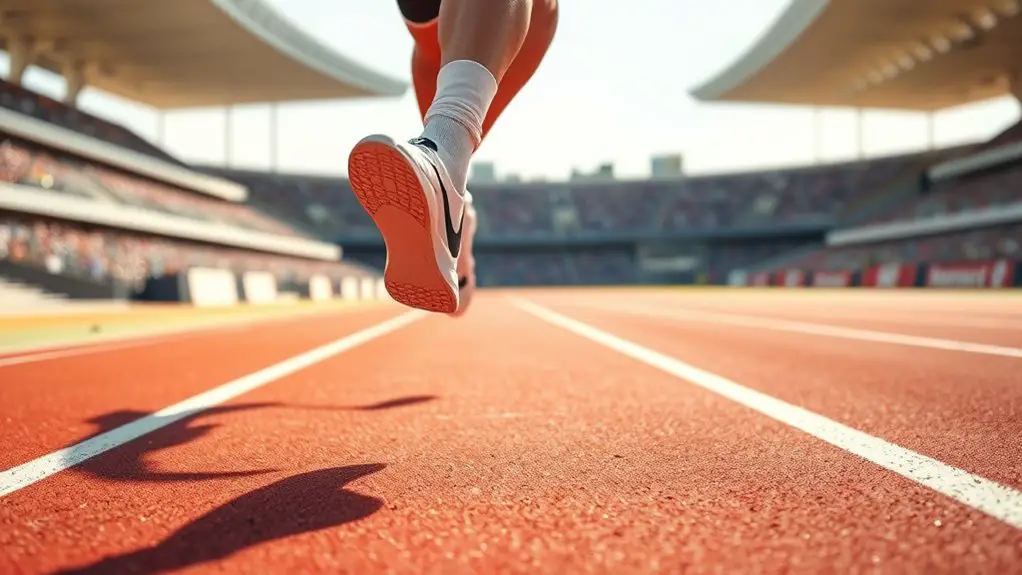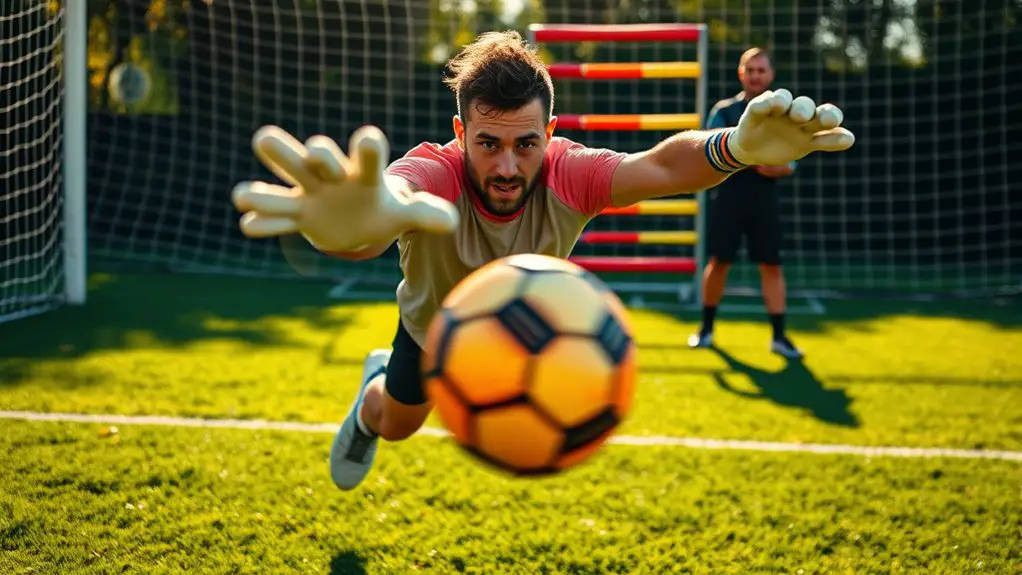Ankle mobility plays an essential role in sprint acceleration. When you have greater ankle flexibility, you can achieve better dorsiflexion, allowing for more powerful ground pushes and a smoother stride. This leads to improved speed and reduces your risk of injury. Limited mobility, on the other hand, can hinder performance and decrease stride length. By prioritizing ankle mobility, you can enhance your sprinting efficiency and confidence. There's more to discover about maximizing your performance through ankle training techniques.
Understanding Ankle Mobility and Its Importance
When you think about sprint acceleration, it's easy to overlook the role of ankle mobility, yet it's essential for optimizing your performance. Your ankle anatomy plays a critical role in how efficiently you move, allowing for the explosive power needed in sprinting. With greater ankle mobility, you can achieve a deeper range of motion, which translates to more forceful pushes off the ground.
The mobility benefits extend beyond just speed; they also promote stability and reduce the risk of injuries. When your ankles can flex and extend freely, you're not just running faster—you're running with freedom and confidence. Imagine feeling unrestricted as you power down the track, each stride fueled by well-functioning joints. By prioritizing ankle mobility in your training, you're equipping yourself with the tools to break free from limitations and release your full sprinting potential. Embrace the journey toward improved performance through enhanced ankle flexibility. Additionally, prioritizing mobility training allows for enjoyment of sport without injury fear.
The Biomechanics of Sprinting: Role of the Ankles
Ankle mobility directly influences the biomechanics of sprinting, shaping how you generate speed and power. When you sprint, proper ankle dorsiflexion biomechanics allow your foot to land beneath your center of gravity, promoting an efficient stride. This positioning reduces the risk of injury and maximizes your force production.
As your ankle moves into dorsiflexion, it prepares for a powerful push-off, optimizing your plantarflexion power. This explosive movement helps you propel forward, aiding acceleration and overall sprint performance.
If your ankles can flex adequately, you'll achieve a better range of motion, allowing for a more dynamic gait. This freedom in movement not only enhances your speed but also contributes to a smoother running experience. By focusing on ankle mobility, you reveal your potential, paving the way for faster sprints and improved athletic performance. Embrace the importance of your ankles, and feel the difference in your sprinting! Incorporating plyometric exercises can further enhance your ankle strength and explosiveness.
How Limited Ankle Mobility Affects Acceleration
Limited ankle mobility can greatly hinder your sprint acceleration, as it restricts your ability to effectively engage in dorsiflexion. When your ankles are stiff, the impact on your overall performance can be significant. Increased ankle stiffness effects can lead to inefficient force transfer and a reduced stride length, making it harder to achieve your sprinting goals. Strengthening exercises for hamstring resilience can also play a crucial role in improving overall sprint performance.
Here's a quick overview of how mobility training can counter these issues:
| Aspect | Ankle Stiffness Effects | Mobility Training Benefits |
|---|---|---|
| Force Production | Decreased | Increased |
| Stride Length | Reduced | Enhanced |
| Sprint Speed | Slower | Faster |
| Injury Risk | Higher | Lower |
| Overall Performance | Compromised | Optimized |
Improving your ankle mobility through targeted training not only enhances your sprint acceleration but also empowers your freedom to move with fluidity and speed.
Assessing Your Ankle Flexibility
To determine how well your ankles can move, evaluating your ankle flexibility is essential. Start with a simple ankle assessment to gauge your range of motion. One effective flexibility test is the wall dorsiflexion test. Stand facing a wall, place your foot a few inches away, and bend your knee towards the wall, aiming to touch it without lifting your heel. If you can't reach the wall, it might indicate limited ankle flexibility.
Another test involves the calf stretch. Place one foot behind the other and lean forward, keeping your back heel down. If you feel tightness in your calf or can't maintain balance, your flexibility could use some work.
These assessments are quick and easy, giving you valuable insights into your ankle mobility. Enhanced flexibility is crucial for improving overall athletic performance, as it allows for more fluid movements. Knowing where you stand can empower you to make the changes necessary for improved performance and freedom in your movement.
Strategies to Improve Ankle Mobility
To boost your ankle mobility, you'll want to focus on both stretching techniques and strengthening exercises. Incorporating targeted stretches can enhance flexibility, while strength training will support the muscles around your ankles. Together, these strategies can lead to improved performance in your sprinting.
Stretching Techniques
While many athletes focus on strength and conditioning, improving ankle mobility through effective stretching techniques is essential for enhancing sprint acceleration. Incorporating dynamic stretching into your warm-up routine can be a game-changer. Movements like ankle circles and lunges not only increase blood flow but also prepare your joints for explosive action. On the other hand, static stretching, done post-workout, helps elongate the muscles and improve flexibility. Try holding calf stretches or dorsiflexion stretches for 30 seconds to truly feel the difference. By balancing both dynamic and static stretching, you'll give your ankles the freedom they need to perform at their best. Remember, a little focus on mobility can lead to big gains in your sprint performance.
Strengthening Exercises
After incorporating effective stretching techniques, it's time to focus on strengthening exercises that can further enhance ankle mobility. Engaging in ankle strengthening exercises will help you build resilience and improve overall function. Start with simple mobility drills like toe raises and heel walks, which activate your ankle muscles and enhance stability. You can also try resistance band exercises to target specific muscles, allowing for greater range of motion. Incorporate single-leg balance drills to challenge your proprioception and strengthen your ankles under dynamic conditions. Remember, consistency is key; aim for a few sessions a week. By committing to these exercises, you'll not only improve your ankle mobility but also release your sprinting potential and enjoy the freedom of movement.
Incorporating Ankle Mobility Exercises Into Training Regimens
Incorporating ankle mobility exercises into your training regimen is essential for enhancing sprint acceleration and overall performance. By integrating dynamic warm ups and mobility drills, you'll increase flexibility and strength, allowing your ankles to function efficiently during sprints. Additionally, prioritizing flexibility and mobility fosters freedom of movement in sports, which can significantly improve your sprinting capabilities.
Here's a simple table to help you structure your ankle mobility routine:
| Exercise | Duration/ Reps |
|---|---|
| Ankle Circles | 2 sets of 10 reps |
| Calf Stretch | 30 seconds each side |
| Toe Raises | 3 sets of 15 reps |
| Dorsiflexion Stretch | 30 seconds each side |
| Heel Walks | 2 sets of 20 meters |
Frequently Asked Questions
Can Poor Ankle Mobility Lead to Injuries in Sprinters?
Imagine a bird trying to fly with clipped wings; that's what poor ankle mobility does to a sprinter. It restricts your movement, making you more susceptible to ankle injuries. If you're working for freedom in your sprints, mobility improvement is essential. Think of it as releasing your potential—when your ankles move freely, you're not just running; you're soaring. Don't let limited mobility ground you; embrace the journey toward greater agility and strength.
How Often Should I Assess My Ankle Mobility?
You should assess your ankle mobility regularly, ideally every few weeks. This frequency aligns well with your sprint training routine, allowing you to track improvements and address any limitations before they become issues. Incorporating ankle mobility assessments into your training schedule helps maintain your freedom of movement and enhances performance. Staying proactive about your ankle health guarantees you can sprint with confidence and enjoy the process without worrying about potential setbacks.
Are There Specific Stretches for Ankle Mobility?
To improve your ankle mobility, you can incorporate both dynamic and static stretches into your routine. Dynamic stretches, like ankle circles and toe raises, help warm up your joints and increase blood flow. For static stretches, try holding a calf stretch or a seated forward bend to lengthen the muscles. Remember, your body craves freedom of movement, so keep it fluid and adaptable—your ankles will thank you for the care!
How Does Footwear Affect Ankle Mobility During Sprinting?
You might think that any shoe will work for sprinting, but footwear really affects your ankle mobility. Shoes with too much cushioning can hinder your natural movement, limiting flexibility. If your shoes are too rigid, they won't allow your ankles to move freely, which can impact your performance. Choosing footwear that balances cushioning and flexibility can enhance your sprinting experience, giving you the freedom to move more efficiently and comfortably.
Can Ankle Mobility Impact Other Sports Performance?
Absolutely, ankle flexibility can greatly impact your overall sports performance. If you've got good ankle mobility, you're more likely to achieve better balance and stability, which is essential in many sports. Whether you're jumping, cutting, or changing directions, your ankles play a key role. By improving your ankle flexibility, you'll not only enhance your agility but also reduce the risk of injury, giving you the freedom to perform at your best.




